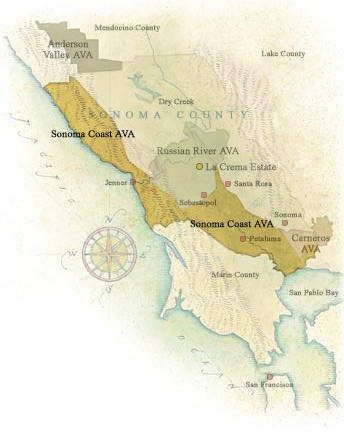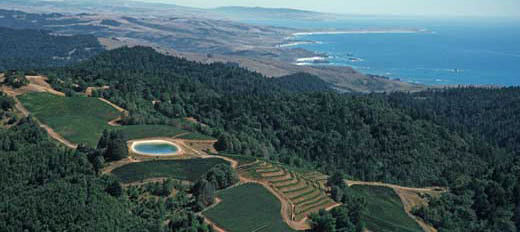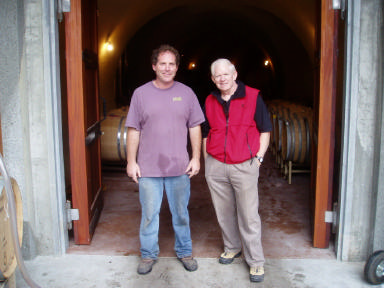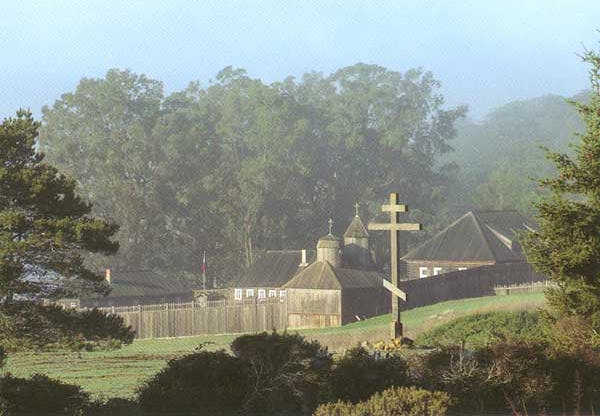Fort Ross: Growing Pinot On the Edge
“It’s a long way from anywhere. It’s markedly cold - 10 degrees cooler
than Napa Valley on average. It’s extremely foggy. There’s no infrastructure.
It’s lonely. The locals don’t like outsiders. Strong winds break the vine
shoots. There’s a high risk of devastation by wild pigs. Gophers frequent
the area in droves.” Susan Keevil, The Wine News. June/July 2004.
Growing Pinot Noir along the most western reaches of the Sonoma Coast might be
regarded as pure folly to many, but the dedicated band of winegrowers who have
accepted the challenge know that the fickle grape feels right at home here. This
region is quickly becoming one of the epicenters of fine Pinot Noir in California.

The Sonoma Coast AVA is the largest of
the 13 AVAs in Sonoma County at 750
square miles. This cumbersome AVA
was formed in 1987 primarily to allow
certain wineries to include all of their
scattered major vineyards within one
boundary so they could use the “estate
bottled” designation on their wine labels.
The Sonoma Coast AVA is defined by its
coolness, with no more than 2,800 degree
days of heat during the growing season.
It is sandwiched between the mountains
and the Pacific Ocean, and with its high
winds, daily fog, and cold temperatures,
is a hostile environment only Pinot Noir
could love. The vineyards are situated
primarily above the fog line or in lower
reaches where the wind blows off the fog.
There are an endless number of microclimates
and soil types in the Sonoma Coast
AVA, but the common denominator is the area’s coolness.
The Sonoma Coast AVA extends from the Sonoma County border with Napa in Carneros to the east, to
Marin County to the south, to the Pacific Ocean to the west, and to the Russian River Valley AVA
boundary to the north. It overlaps five other AVAs including the Sonoma part of Carneros, a sliver of
Sonoma Valley, the western part of Chalk Hill, all of Green Valley, and most of the Russian River
Valley. Although the AVA is 517,000 acres and almost half the size of Sonoma County, only 7,000 acres
are planted to vineyards. Fifty growers and six wineries are located within the AVA’s borders.
Because of the unwieldy immensity of the Sonoma Coast AVA, a portion has been unofficially divided
into the “true” Sonoma Coast. This subdivision is roughly from Jenner in the south where the Russian
River empties into the Pacific Ocean to Annapolis in the north and from the beaches of the Pacific
Ocean to 5-6 miles inland including the first two ridges of the Coastal Range of mountains and the
western slope of the third ridge. Besides Annapolis and Jenner, Occidental and Freestone are usually
included, although both are south of Jenner.
Eventually, the true Sonoma Coast may itself be broken into smaller AVAs. A small portion, the Fort
Ross-Seaview area, above 920 feet elevation, applied for its own sub-AVA designation in 2003. There
are only ten winegrowers in Fort Ross-Seaview, which includes the area around Fort Ross.
Fort Ross was established in 1812 by the Russian-American Company. In 1817, grapevines were
brought from Peru and planted on a hillside near Fort Ross. These plantings predate others to follow in
Napa and Sonoma counties. The area became known for logging and ranching, and it wasn’t until the
later 20th century that grapes were reintroduced in any significant amounts.
Mike Bohan was the first person in the modern era to plant grapes in the true Sonoma coast. In 1973,
he developed a vineyard on Bohan Dillon Road which included Zinfandel, Pinot Noir, Chardonnay and
Riesling. David Hirsch was another visionary who came to the area shortly thereafter. In 1978, he has become synonymous with the true Sonoma Coast. The list of subsequent pioneers in the true Sonoma
Coast reads like a who’s who of California Pinot Noir. The names include Helen Turley and John
Wetlaufer (Marcassin), Lee Martinelli (Martinelli), Bill Smith (W.H. Smith), Ted Lemon (Littorai), Walt
and Joan Flowers (Flowers), Mark Bixler and Steve Kistler (Kistler Vineyards), and Daniel and Marian
Schoenfield (Wild Hog). More recently, there has been considerable investment in the true Sonoma
Coast by several prominent Napa wineries including Caymus (Belle Glos), Pahlmeyer, Peter Michael,
Benziger, and Joseph Phelps.
Lester and Linda Schwartz came to the true Sonoma Coast from an unlikely location, South Africa.
While students at the University of Cape Town in the 1960s, they met and shared their love for food and
wine. They married in 1967, and emigrated to the United States nine years later, settling in the San
Francisco Bay Area. Lester longed for the country life he grew up with in South Africa and located a
remote property in the high coastal ridges near the Pacific Ocean, just south of the small town of Fort
Ross. He and Linda purchased the property, built an unusual house offering dramatic views of the surrounding
countryside, and planted a vineyard.
Linda studied viticulture at Santa Rosa Junior College and took classes at University of California Davis.
Although her background was in music composition, she had an affinity for working the soil and operating
farm equipment. Lester and Linda, along with a small crew, began in 1994 to develop their 44-
acre vineyard. They installed a sub-surface drainage system and miles of fencing to keep out the deer
and wild boar. Preliminary plantings with a test vineyard indicated the area was ideal for growing
Pinot Noir and Chardonnay. The vineyard is less than a mile from the Pacific Ocean, and is one of the
closest, if not the closest vineyard to the ocean in all of coastal California. A total of 28 vineyard blocks
ranging in size from one-half to two acres are planted in heterogeneous microclimates scattered over
the ridge tops at 1200 to 1700 feet. Pinot Noir plantings included field selections of Calera, Pommard,
Swan and Dijon clones 115 and 777.

Crop yields at Fort Ross, like most areas in the true Sonoma Coast, are low, usually between one and
three tons per acre. The cool climate produces very small berries with high juice-to-skin and juice-toseed
ratios. This leads to very concentrated flavors and amplified tannins. When ripe, the Pinot Noirs
can be earthy, bold and dense. Ted Lemon (Littorai) has characterized Sonoma Coast Pinot Noir as
follows: “Muscle and sinew, grit, structure, more backbone and tannins than the Russian River Valley
Pinot Noir, peppery in leaner years with sage and savory as the prominent spices.” Dan Goldfield
(Dutton-Goldfield) feels that what sets Sonoma Coast Pinot Noir apart is “the mineral element and very
focused tannins compared with the Russian River Valley sweet fruit and floral elements.”
One of the unique features of the Fort Ross vineyard is the plantings of Pinotage. Lester and Linda had
fond memories of Pinotage from their early years in South Africa. They sourced bud wood from two of
the best blocks in South Africa and were the first private growers to bring these cuttings through the
Foundation Plant Services that operates in conjunction with the University of California Davis School of
Viticulture and Enology. Pinotage was originally bred in South Africa in 1925 at Stellenbosch University
by Professor Perold who crossed Pinot Noir and Cinsaut (often called Hermitage in South Africa,
the source of the name is confusing as Cinsaut is neither grown in the Rhone or included in Hermitage
wine). At first, it was enthusiastically touted as having the flavors of Pinot Noir with the high yields and
easy ripening of Cinsaut. However, it never offered the alluring flavors of Pinot Noir or even the taste
of Cinsaut. In spite of this, Pinotage did develop a following and with appropriate low-yields and handling
in the winery, it can be an original wine of interesting charm and distinctive flavors unlike any
other varietal. When young it is said to taste like Gamay Beaujolais, as it matures it resembles a Rhone
wine, and in maturity has the characteristics of a well-aged Bordeaux wine. The Schwartzes have had
success with Pinotage, and theirs is one of the best examples in the world. For more information on
Pinotage, consult the Pinotage Association’s website, www.pinotage.co.za.
The inaugural vintage for Fort Ross Vineyard was 2001. Fred Scherrer (Scherrer Winery) was the initial
winemaker. Ed Kurtzman (formerly Bernardus, Chalone and Testarossa, currently Freeman and
August West) started with Fort Ross in 2003. He made all of the wines in 2003 except for the Reserve
Pinot Noir, which Fred crafted, and has continued to the present as the sole winemaker. Ed hails from
Boston, Massachusetts, where he majored in history and sociology while attending the University of
Massachusetts. While in college, he worked in a wine shop and subsequently moved to California to
sell wine in the Bay Area. He quickly realized that he would rather make wine than sell it, and attended
Fresno State to obtain his degree in enology. The Schwartzes feel very fortunate to have Ed
and his 17 years of winemaking experience with cool climate varietals.
Ed told me that his goal at Fort Ross is not to shoot for a certain style, but rather let the vineyard do the
talking. He has found the vineyard produces wines with notable tannin, in excess of what he is used to
working with. When I tasted through several Fort Ross Pinot Noirs recently, I found the flavors more
expressive than the aromatics. The reason, Ed says, is that more tannic fruit needs additional time for
the aromatics to come alive. The 2004 and 2006 vintages are probably the ones that have hit their
stride earlier than other vintages in this regard.

2006 Southern Right Cellars South Africa Pinotage
14.0% alc., $19.
Imported by Vineyard Brands Inc., Birmingham, Alabama. Grown in Walker Bay close to the south Atlantic Ocean and named after the rare Southern Right whale which visits Walker Bay each year. I thought it would be interesting to sample a South African Pinotage side-by-side with the Fort Ross Pinotage. Selections of Pinotage in
retail wine stores is quite limited and I may not have chosen an appropriate bottle to compare.
·
This wine was dark violet in color with an unpleasant nose of burnt wood. Stalky, woody and a bit sour with a
dry finish, there was no fruit to be found. This was an unpleasant wine to drink. Perhaps it had an unfortunate
experience on its trip to the States.
2005 Fort Ross Vineyard Reserve Sonoma Coast Pinot Noir
14.0% alc., 500 cases, $60.
A barrel selection of the property’s finest wine. Not released on winery’s website for sale but obtained thru a
retail source.
·
This is a spirited wine showing black cherry fruit with a touch of Asian spice and oak. The
aromatics are unyielding and the wine needs time to shed its tannins. This is a debutante waiting in the
wings to come out. A few years in the cellar will highly reward the patient drinker.
2004 Fort Ross Vineyard Sonoma Coast Pinot Noir
14.5% alc., 917 cases, $39.
A year with light berry set. Some blocks only produced a
half ton per acre. Harvest was mid to late September. Aged 11 months
in 45% new French oak. Pommard, Swan, Dijon 115, 777 clones.
·
A nondescript perfume with a hint of strawberry and peppermint. Understated
with light-weight fruit. Soft, elegant and nicely balanced.
2004 Fort Ross Vineyard Reserve Sonoma Coast Pinot Noir
14.5% alc., 370 cases, $49.
Calera and Dijon 115 clones. Aged 11 months in 50% new French oak.
·
This wine’s aromatics are a little more expressive with darker fruits, cola and sawdust.
The blue and black Pinot fruits are nicely spiced. Soft and pillowy, the balance is right on. This
beauty is deserving of the Reserve designation and among the wines tasted, showing the most leg at this
time. Queen of the Hop.
2003 Fort Ross Vineyard Sonoma Coast Pinotage
14.7% alc., 400 cases, $32.
Pinotage is vinified in a similar fashion as Pinot Noir. After a cold soak and fermentation in open-top fermenters, the wine is pressed and aged in primarily one-year-old French oak for 15 months. It is estate grown from proprietary Pinotage clones and is bottled unfined and unfiltered.
·
A very complex nose featuring cherry, cranberry, iodine, spearmint, wax and even fresh paint. Luscious hi-tone black raspberry fruit with a hint of spice. Velvety in texture with ripe, suave tannins. Excellent!
2003 Fort Ross Vineyard Symposium Sonoma Coast Pinot Noir
14.7% alc., 688 cases, $32. 96%
Pinot Noir and 4% Pinotage. Aged 16 months in 50% new French oak.
·
An earth-based nose with moodier and darker fruits. A little pepper and farmyard adds interest. Delicious flavors of cherry pie, nutmeg, strawberries and cookie dough. Nicely balanced with an appropriate acid backbone.
2001 Fort Ross Vineyard Reserve Sonoma Coast Pinot Noir
14.5% alc., 112 cases.
Individual blocks were harvested on multiple occasions based upon flavor profile and ripeness of each vine.
Yields were low. The clones and different vineyard blocks were kept separate during winemaking.
The final blend was chosen from barrels which had distinctive fruit concentration, complexity and
balance. Aged 18 months in 60% new French oak.
·
Lightest in color of the wines tasted with a slight auburn cast to rim. Initially the nose was subtle but seductive with cherries and fresh-sawed oak. Over time, the aromas came alive with savory cherry and spice enhanced by old wood and leather charm. Red cherry flavors were soft and light. The fruit has faded a bit, but I liked this wine for its finesse. Drink up.
There are several unifying traits noted in the Fort Ross Vineyard wines. The wines consistently exhibit
very admirable balance. The style is understated and elegant. The aromatics can be quite shy and
may benefit from decanting and/or further aging. The flavors are more showy and alluring.
Tasting through this series of wines reconfirmed by continuing impression that you must give Pinot
Noir time to open up! Looking at all of the additions and deletions in my notes, it is clear that Pinot Noir
is a chameleon, always changing in the glass. The problem with tasting notes is that they often reflect
a small window in time. This is why I taste wines over at least an hour time period. The aromatic and
flavor profiles will often pick up interest and complexity over this time. If the wine is still unyielding, I
will decant or taste from the opened bottle the next day. Be patient and you will often be surprised!
Fort Ross Vineyard sales office is 550 Indiana St, San Francisco, CA. The wines are available on the
website at www.FortRossVineyard.com. Vintages dating back to 2002 can be purchased from the winery’s
library. The phone is 415-701-9200. There is also an excellent Chardonnay and Rosé available
for sale.

Historical Note. The settlement of Ross (the name was derived from the word for Russia or Rossiia) was
established by the Russian-American Company, a commercial hunting and trading company chartered
by the tsarist government, with shares held by the members of the Tsar’s family, court nobility and
high officials. The colony was set up to provide a food source for Alaskan outposts and to hunt sea
otters. Kuskov arrived at Ross in 1812 with a party of 25 Russians, many of them craftsman, and 80
native Alaskans. After negotiating with the Kashaya Pomo Native Americans who inhabited the area,
Kuskov began construction of the fort (see photo above). The design of the fort followed models of the
traditional stockade, blockhouses, and log buildings found in Siberia and Alaska.